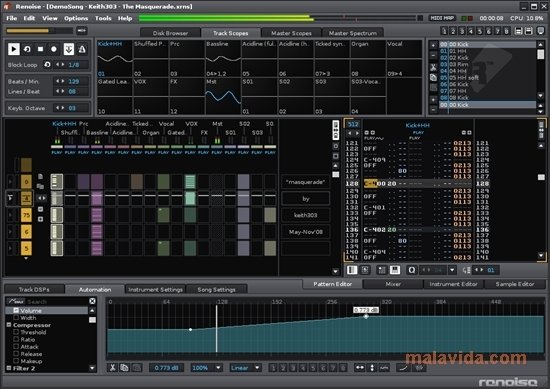

Here we’ll show you how to program changes throughout a track. Automation proclamationĪutomation is essential for adding motion and interest to your music, and Renoise offers a few different ways to handle it. There’s the added bonus that Doofers also come with their own Macro controls. When you find something you like, pack it into a single Doofer (other DAWs call them racks) and save it as a preset. With the multitude of native effects, meta and routing devices on offer (and their associated parameters), it can be hard to keep track of your favourite combinations. The results can then be recorded into the pattern as automation. Multiple parameters can be assigned to each one, so you can, for example, simultaneously shorten the length of a sample while increasing its reverb. Gain quick and easy access to your favourite modulation and FX parameters by assigning them to one of eight Macro knobs. By repeating and dampening the sound over and over again, this simulates spatial effects. Delay Devices Delay devices repeat an audio signal and mix it with the original sound. Crucially, you can nest multiple groups inside another group, and continue doing that up to six layers deep, opening up a world of possibilities. Renoise and Redux provide a wide range of native effect devices that can be used to alter the input audio in a variety of ways. MIDI and plugin instruments can also be automated through Instrument MIDI Control or Instrument Automation devices. Renoise features nested track grouping, which is not only good for organising tracks, but also processing them, as effects placed at the group level affect all tracks below it. Take care that you also add the instrument number, so that Renoise knows which MIDI instrument the command will be targeting. Click Help > List Pattern Effect Commands to see them all. Its primary use is the composition of music using.

Commands perform all sorts of tasks, from manipulating sample audio (triggering sample offsets or portamento glides) to automating track effects and even controlling song playback. Renoise is a digital audio workstation (DAW) based upon the heritage and development of tracker software. You can also automate effects using Track Automation or Pattern Effect. Command and conquerĮffects Commands separate trackers from other DAWs, so knowing them is essential to unlocking the power of Renoise. It selects whether to parse VST effect parameters into Renoise window or not. Time spent here can reap significant sonic rewards. Each modulation device is placed in sequence and affects the next device by the type of operand selected between them. In the Modulation section of the Sampler tab, you can create complex modulation for basic sample parameters such as volume, pitch, frequency cutoff, resonance and drive. These pitch- and volume-independent Phrases are then triggered like any other instrument in the main Pattern Editor. Here, you can create anything from a single hit, chord or arpeggio, to a breakbeat or complex harmony. One of the most revolutionary features in Renoise is the Phrase Editor, found in the Sampler tab. Renoise is capable of loading 3rd party plugins (VST/AU) and has a built-in 32-bit to 64-bit plugin bridge for handling those older plugins.


 0 kommentar(er)
0 kommentar(er)
